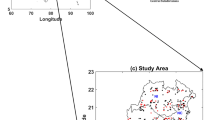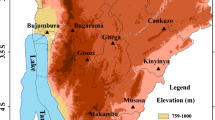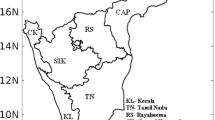Abstract
Extreme rainfall events (EREs) are very localized and intense events witnessing heavy rainfall resulting in flash floods and landslides in the Himalayan region. The trend of EREs in the state of Himachal Pradesh shows an increasing trend, so in this study, an attempt is being made for quantifying the climatological feature of these EREs in the state of Himachal Pradesh in the western Himalayan mountain region. Multi-source observed datasets for the long-term period, i.e., 1901 to 2020, are considered for the analysis. The climatology analysis indicates that northern and southern parts of Himachal Pradesh receive comparatively more rainfall, and the state witnessed a decreasing trend of the rainfall in the current decade. The classifications of these EREs in terms of monsoon and non-monsoon with a different threshold of daily rainfall are being analyzed, and it is found that almost 90% of extreme events are observed in the monsoon season. The zone centered around 32.5° N and 76.25° E seems to be the hotspot for the frequent EREs in the mountainous state. The spatial analysis of the ERE trend also indicated that almost 40% of the state witnesses the heavy rainfall throughout the years. This observational study will surely help in understanding the dynamics of these EREs in the higher altitude regions and can be used for hydro-meteorological disaster management and mitigation.









Similar content being viewed by others
Data availability
IMD gridded data is used for the analysis.
Code availability
Data analysis codes are available from the corresponding author upon reasonable request.
References
Alexander LV, Zhang X, Peterson TC, Caesar J, Gleason B, Klein Tank AM, Haylock M, Collins D, Trewin B, Rahimzadeh F, Tagipour A, Rupa Kumar K, Revadekar J, Griffiths G, Vincent L, Stephenson DB, Burn J, Aguilar E, Brunet M, Taylor M, New M, Zhai P, Rusticucci M, Vazquez-Aguirre JL (2006) Global observed changes in daily climate extremes of temperature and precipitation. J Geophys Res Atmos 111(D5):D05109
Bhan SC, Paul S, Kharbanda KL (2004) Cloud bursts in Himachal Pradesh. Mausam 55(4):712–713
Bhan SC, Devrani AK, Sinha V (2015) An analysis of monthly rainfall and the meteorological conditions associated with cloudburst over the dry region of Leh (Ladakh), India. Mausam 66(1):107–122
Bhardwaj A, Wasson RJ, Ziegler AD, Chow WT, Sundriyal YP (2019) Characteristics of rain-induced landslides in the Indian Himalaya: a case study of the Mandakini Catchment during the 2013 flood. Geomorphology 330:100–115
Bhardwaj A, Wasson RJ, Chow WT, Ziegler AD (2021) High-intensity monsoon rainfall variability and its attributes: a case study for Upper Ganges Catchment in the Indian Himalaya during 1901–2013. Nat Hazards 105(3):2907–2936
Bhutiyani MR, Kale VS, Pawar NJ (2010) Climate change and the precipitation variations in the northwestern Himalaya: 1866–2006. Int J Climatol 30(4):535–548
Bokhari SAA, Ahmad B, Ali J, Ahmad S, Mushtaq H, Rasul G (2018) Future climate change projections of the Kabul River Basin using a multi-model ensemble of high-resolution statistically downscaled data. Earth Systems and Environment 2(3):477–497
Bookhagen B, Burbank DW (2006) Topography, relief, and TRMM‐derived rainfall variations along the Himalaya. Geophys Res Lett 33(8):L08405
Buerkert A, Fernandez E, Tietjen B, Luedeling E (2020) Revisiting climate change effects on winter chill in mountain oases of northern Oman. Clim Change 162(3):1399–1417
Chaudhuri C, Tripathi S, Srivastava R, Misra A (2015). Observation-and numerical-analysis-based dynamics of the Uttarkashi cloudburst. Ann Geophys 33(6):671–686. Copernicus GmbH
Chen S, Hamdi R, Ochege FU, Du H, Chen X, Yang W, Zhang C (2019) Added value of a dynamical downscaling approach for simulating precipitation and temperature over Tianshan mountains area, Central Asia. J Geophys Res: Atmos 124(21):11051–11069
Crochet P (2007) A study of regional precipitation trends in Iceland using a high-quality gauge network and ERA-40. J Clim 20(18):4659–4677
Das S, Ashrit R, Moncrieff MW (2006) Simulation of a Himalayan cloudburst event. J Earth Syst Sci 115(3):299–313
Dimri AP, Dash SK (2012) Wintertime climatic trends in the western Himalayas. Clim Change 111(3):775–800
Dimri AP, Chevuturi A, Niyogi D, Thayyen RJ, Ray K, Tripathi SN, … Mohanty UC (2017) Cloudbursts in Indian Himalayas: a review. Earth Sci Rev 168:1–23
Done JM, Holland GJ, Bruyère CL, Leung LR, Suzuki-Parker A (2015) Modeling high-impact weather and climate: lessons from a tropical cyclone perspective. Clim Change 129(3):381–395
Duan K, Yao T, Thompson LG (2006) Response of monsoon precipitation in the Himalayas to global warming. J Geophys Res 111:D19110
Durand Y, Laternser M, Giraud G, Etchevers P, Lesaffre B, Mérindol L (2009) Reanalysis of 44 yr of climate in the French Alps (1958–2002): methodology, model validation, climatology, and trends for air temperature and precipitation. J Appl Meteorol Climatol 48(3):429–449
Easterling DR, Meehl GA, Parmesan C, Changnon SA, Karl TR, Mearns LO (2000) Climate extremes: observations, modeling, and impacts. Science 289(5487):2068–2074
Fischer EM, Knutti R (2016) Observed heavy precipitation increase confirms theory and early models. Nat Clim Chang 6(11):986–991
Fischer EM, Beyerle U, Knutti R (2013) Robust spatially aggregated projections of climate extremes. Nat Clim Chang 3(12):1033–1038
Goswami BN, Venugopal V, Sengupta D, Madhusoodanan MS, Xavier PK (2006) Increasing trend of extreme rain events over India in a warming environment. Science 314(5804):1442–1445
Goswami P, Ramesh KV (2006) A comparison of interpolated NCEP (I‐NCEP) rainfall with high‐resolution satellite observations. Geophys Res Lett 33(19):L19821
Guhathakurta P, Rajeevan M (2008) Trends in the rainfall pattern over India. Int J Climatol 28(11):1453–1469
Hanlon HM, Bernie D, Carigi G, Lowe JA (2021) Future changes to high impact weather in the UK. Clim Change 166(3):1–23
Karki R, ul Hasson S, Gerlitz L, Talchabhadel R, Schenk E, Schickhoff U, ... Böhner J (2018)WRF-based simulation of an extreme precipitation event over the Central Himalayas: atmospheric mechanisms and their representation by microphysics parameterization schemes.Atmos Res 214:21–35
Kharin VV, Zwiers FW, Zhang X, Hegerl GC (2007) Changes in temperature and precipitation extremes in the IPCC ensemble of global coupled model simulations. J Clim 20(8):1419–1444
Kharin VV, Zwiers FW, Zhang X, Wehner M (2013) Changes in temperature and precipitation extremes in the CMIP5 ensemble. Clim Change 119(2):345–357
Kyselý J, Beranová R (2009) Climate-change effects on extreme precipitation in central Europe: uncertainties of scenarios based on regional climate models. Theoret Appl Climatol 95(3):361–374
Meehl GA, Zwiers F, Evans J, Knutson T, Mearns L, Whetton P (2000) Trends in extreme weather and climate events: issues related to modeling extremes in projections of future climate change. Bull Am Meteor Soc 81(3):427–436
Moraga JS, Peleg N, Fatichi S, Molnar P, Burlando P (2021) Revealing the impacts of climate change on mountainous catchments through high-resolution modelling. J Hydrol 603:126806
Orlowsky B, Seneviratne SI (2012) Global changes in extreme events: regional and seasonal dimension. Clim Change 110(3):669–696
Pai DS, Rajeevan M, Sreejith OP, Mukhopadhyay B, Satbha NS (2014) Development of a new high spatial resolution (0.25× 0.25) long period (1901–2010) daily gridded rainfall data set over India and its comparison with existing data sets over the region. Mausam 65(1):1–18
Pant GB, Kumar PP, Revadekar JV, Singh N (2018) Climate change in the Himalayas. Springer International Publishing
Poveda G, Espinoza JC, Zuluaga MD, Solman SA, Garreaud R, Van Oevelen PJ (2020) High impact weather events in the Andes. Front Earth Sci 8:162
Saddique N, Khaliq A, Bernhofer C (2020) Trends in temperature and precipitation extremes in historical (1961–1990) and projected (2061–2090) periods in a data scarce mountain basin, northern Pakistan. Stoch Env Res Risk Assess 34(10):1441–1455
Sontakke NA, Singh HN, Singh N (2010) Monitoring physiographic rainfall variation for sustainable management of water bodies in India. In: Natural and Anthropogenic Disasters. Springer, Dordrecht, pp 293–331
Talchabhadel R, Karki R, Thapa BR, Maharjan M, Parajuli B (2018) Spatio-temporal variability of extreme precipitation in Nepal. Int J Climatol 38(11):4296–4313
Umar S, Lone MA, Goel NK (2021) Modeling of annual rainfall extremes in the Jhelum River basin, North Western Himalayas. Sustain Water Resour Manag 7(4):1–13
Valipour M, Eslamian S (2014) Analysis of potential evapotranspiration using 11 modified temperature-based models. Int J Hydrol Sci Technol 4(3):192–207
Valipour M, Sefidkouhi MAG, Raeini M (2017) Selecting the best model to estimate potential evapotranspiration with respect to climate change and magnitudes of extreme events. Agric Water Manag 180:50–60
Vanden Broucke S, Wouters H, Demuzere M, van Lipzig NP (2019) The influence of convection-permitting regional climate modeling on future projections of extreme precipitation: dependency on topography and timescale. Clim Dyn 52(9):5303–5324
Zhang H, Zhai P (2011) Temporal and spatial characteristics of extreme hourly precipitation over eastern China in the warm season. Adv Atmos Sci 28:1177. https://doi.org/10.1007/s00376-011-0020-0
Zhang Q, Singh VP, Sun P, Chen X, Zhang Z, Li J (2011) Precipitation and streamflow changes in China: changing patterns, causes and implications. J Hydrol 410(3–4):204–216
Funding
This work is supported by the projects funded by the National Mission on Himalayan Studies (NMHS) of Ministry of Environment, Forest and Climate Change (MoEFCC), Govt. of India, for the project funding support (grant no: GBPNI/NMHS-2019–20/MG/315).
Author information
Authors and Affiliations
Contributions
Conceptualization: Krushna and Sudhansu. Analysis and investigation: Sudhansu, Krushna, Nidhi, Sayanta, and Renu. Writing—original draft preparation: Krushna, Sudhansu, Sayanta, Renu, and Nidhi.
Corresponding author
Ethics declarations
Conflict of interest
The authors declare no competing interests.
Additional information
Publisher's note
Springer Nature remains neutral with regard to jurisdictional claims in published maps and institutional affiliations.
Rights and permissions
Springer Nature or its licensor (e.g. a society or other partner) holds exclusive rights to this article under a publishing agreement with the author(s) or other rightsholder(s); author self-archiving of the accepted manuscript version of this article is solely governed by the terms of such publishing agreement and applicable law.
About this article
Cite this article
Gouda, K.C., Rath, S.S., Singh, N. et al. Extreme rainfall event analysis over the state of Himachal Pradesh in India. Theor Appl Climatol 151, 1103–1111 (2023). https://doi.org/10.1007/s00704-022-04331-x
Received:
Accepted:
Published:
Issue Date:
DOI: https://doi.org/10.1007/s00704-022-04331-x




